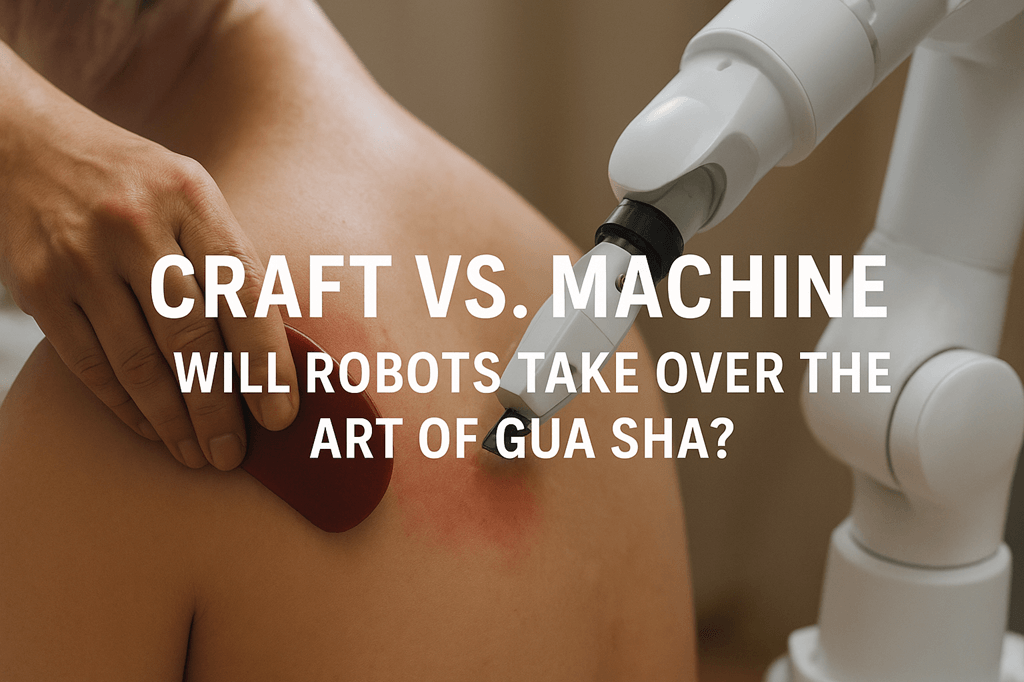
Gua Sha, a traditional Chinese healing method with nearly 2,000 years of history, has long been popular among the public for its affordability, ease of use, and lack of side effects. In recent years, thanks to the spread of social media and the development of other technologies, guasha has become increasingly popular worldwide.
With the advancement of technology, Gua Sha has also seen a growing number of benefits and increasingly intelligent products. This raises the question: Will guasha be taken over by robots in the future?
To answer this question, we conducted a series of analyses of traditional guasha and the potential for robotic Gua Sha.
- The Core of Traditional Gua Sha
- The Advent of Mechanical Gua Sha: Impact with Precision and Intelligence
- Limitations of Mechanical Gua Sha: Smart, But Not Smart Enough
- They are Not Completely Opposite, But Integrated with Each Other.
The Core of Traditional Gua Sha
1. Technology
Gua Sha has been considered a “craft” since ancient times, meaning the focus lies not on the tools but on the technique of the practitioner. For those skilled and experienced practitioners, a smooth ceramic spoon is sufficient, eliminating the need for a variety of tools. Technique is the core and most crucial factor in guasha.
The force, angle, rhythm, and direction of the Gua Sha technique all require adjustment based on the meridians and individual differences. Any inaccurate treatment will negatively impact the overall effect.
2. Perception
Experienced gua sha practitioners do not simply repeat mechanical movements. Instead, they make timely adjustments based on the patient’s actual feedback and the body’s condition. For example, the depth and range of the “sha points”, changes in skin temperature, and the resistance of muscles and skin connective tissue are all very useful and intuitive information for professional and experienced guasha practitioners.
3. Situational
Gua Sha isn’t a cold therapy; it’s a warm one. It often takes place in close and trusting settings—in the mutual care of family members, or between doctors and patients. Verbal communication and necessary physical contact during Gua Sha can soothe patients and foster emotional bonds between families. These emotional touches can’t be replaced by cold machines.
From a Traditional Chinese Medicine perspective, guasha isn’t simply a “physical stimulation” but rather a process of regulating Qi and blood, and connecting the body and mind. Machines still have a long way to go before they can achieve this level of interaction.
The Advent of Mechanical Gua Sha: Impact with Precision and Intelligence

With the rapid advancement of artificial intelligence and the promotion of health technology, Gua Sha, a traditional Chinese medicine practice, is undergoing an unprecedented transformation. A large number of electronic guasha tools have appeared on the market, with those featuring infrared heating already becoming popular. However, considering the current crop of smart Gua Sha tools, the idea of challenging or even replacing traditional guasha remains unrealistic. Current Gua Sha tools still require manual operation and fall within the scope of traditional guasha.
However, research in this area continues. In overseas research, robot-assisted TCM therapy is becoming an emerging trend. Some laboratories have integrated robotic massage with traditional Chinese medicine meridian theory, using robotic arms to precisely control angle, speed, and force, thereby replicating the rhythmic and directional sense of human manipulation. This combination not only improves experimental standardization but also provides a new path for the internationalization and scientific exploration of TCM techniques.
Compared to traditional manual Gua Sha, mechanical guasha may offer certain advantages in terms of cost, stability, and sustainability. Humans can’t work 24 hours a day, but machines can. Assuming no malfunctions, mechanical guasha offers far greater durability than traditional guasha.
Mechanical gua sha allows for stable control of factors such as pressure, frequency, and angle, something traditional manual guasha clearly cannot achieve. This more stable control potentially makes the procedure safer. Mechanical guasha may be more suitable for home guasha, where professional operation and guidance are unavailable.
For large-scale gua sha therapy institutions, mechanical guasha may offer lower operating costs. guasha operators with professional skills and extensive experience are typically highly paid. Furthermore, the number of guasha sessions a professional scraper can perform in a single day is relatively limited, leading to consistently high operating costs. Mechanical guasha, on the other hand, can operate 24 hours a day, and a single machine can simultaneously operate multiple gua sha machines, significantly reducing unit costs.
The emergence of mechanical guasha is not merely an imitation of traditional techniques, but rather an “intelligent evolution.” It has enabled guasha to move from a skill that relies on experience to a modern stage that is measurable, verifiable, and replicable. Precision and efficiency have become the key words, and this ancient therapy has also reached a new technological frontier.
Limitations of Mechanical Gua Sha: Smart, But Not Smart Enough
While it’s foreseeable that mechanical guasha offers breakthroughs in stability and precision compared to traditional guasha, it still has a flaw: it doesn’t “understand” people. Machines can’t think like humans, nor can they provide the same care that humans do.
First, mechanical gua sha lacks individual perception. Everyone’s constitution, skin condition, meridians, and nerve responses are different. A professional gua sha practitioner will adjust their technique to each individual’s individual characteristics, rather than using a single, universally applicable technique. Currently, and for the immediate future, the operating logic of mechanical guasha is largely based on the device’s built-in program, making fine-tuning impossible.
Second, gua sha lacks emotional awareness. In traditional guasha, dialogue and physical contact between the practitioner and the user are crucial components of the treatment, relieving stress and providing timely feedback. However, mechanical guasha lacks these elements, and even if dialogue were possible, it struggles to achieve the same level of human understanding.
Finally, there are cultural factors. Regardless of whether Gua Sha can achieve the “understanding” ability of traditional guasha, even if it can, it cannot completely replace traditional Gua Sha. Traditional guasha is not only a medical method, but also a traditional Chinese culture. In the concept of cultural protection, it will be preserved and passed on for a long time.
They are Not Completely Opposite, But Integrated with Each Other.

The purpose of technology isn’t to completely replace traditional practices, but rather to improve quality and technique. Therefore, the two aren’t mutually exclusive, but rather should embrace and evolve. By introducing intelligent data analysis, sensing technology, and artificial intelligence, guasha can become measurable and more scientific.
In practice, data integration will become a key trend. Through pressure sensing and physiological monitoring, smart devices can record gua sha force, duration, and skin reactions, thereby forming an objective database of procedures. This not only facilitates research on the physiological mechanisms of guasha but also provides users with personalized guidance, such as “optimal intensity ranges,” to avoid risks associated with improper pressure.
Intelligent assistance can also aid beginners in their learning process. Although Gua Sha techniques are simple, errors can easily occur without professional guidance. Intelligent devices can help correct these errors, allowing more people to safely experience and learn this art.
Thus, in the future, rather than a conflict between traditional guasha and robotic Gua Sha, a hybrid model combining “AI Traditional Chinese Medicine Practitioners + Human Therapists” is more likely. That is, through artificial intelligence learning, data analysis, and providing quantitative suggestions, and then performing final operations based on human experience and technology.






